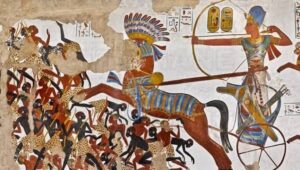
Ramaesses II in his war chariot. By Ahmed88z – Own work, CC BY-SA 4.0, https://commons.wikimedia.org/w/index.php?curid=109307471
The Exodus from Egypt, followed by the invasion and conquest of Palestine, lies at the heart of the Biblical account of Israel’s origins. A number of modern scholars, however, reject the entire story. It is, in their view, little more than a pious fabrication written hundreds of years after the events described. “The Scriptures,” as Robert B. Coote puts it succinctly, “do not contain an [accurate] historical account of Israel’s origin and early history.”1 In the words of another exponent of this school of thought, Thomas L. Thompson, “Israel’s own origin tradition is radically irrelevant to writing … a history [of Israel’s origins].”2
We will examine here three sites described in three different Biblical passages, as well as some of the evidence that supposedly undermines the historical accuracy of the Biblical account.
The first is Dibon, east of the Jordan, mentioned in Numbers 33, where the invading Israelites are said to have encamped. The excavation of Tell Dhiban, ancient Dibon, has revealed no city there in the Late Bronze Age II (c. 1400–1200 B.C.E.), when the Exodus supposedly occurred. Indeed, nothing was found there earlier than the ninth century B.C.E. How could the Israelites encamp at (and presumably conquer) a city that didn’t exist?
Read the rest of Exodus Itinerary Confirmed by Egyptian Evidence in the online Biblical Archaeology Society Library.